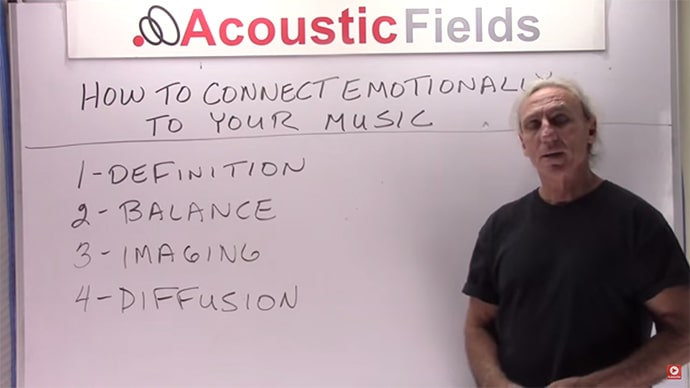The following is an unedited transcript from our video series from Acoustic Fields. There will be some errors in grammar and sentence structure that occur during this translation process.
For complete understanding and comprehension, please view the video which is included in this text. For any additional information regarding this topic or others relating to room acoustics, please contact us directly at:
P: 520 – 392 – 9486
dennis@acousticfields.com
______
When people come to our studio, especially our new studio here in LA and we’ll do a new series of videos on that, the first thing they say is that they can hear everything? And I think that’s important. So, today we’re going to talk a little bit about how to connect emotionally to your music.
There’s certain criteria that we’ve discovered that you really have to have in order to have that connectivity and I think that’s what we’re all after. We’re all after some way to connect emotionally to something these days. It’s crazy as it is but the bottom line here is there are some steps that you can take with your sound stage, with your room, with your audio presentation to get you closer to connect emotionally to the music.
The first and foremost we’ve discovered is definition. You have to be able to hear everything that’s in the source. You have to be able to hear and understand clearly everything that’s in the recording. So you have to be able to define what is there and be able to hear it. If you want to test this out, do a live recording and play something yourself if you can and then put it into your system and play it back and see if you can hear everything that you did. If you can’t, then you know that you have a room issue. It’s not your gear, it’s the room causing the problem. So definition is really critical.
And the next issue that’s really critical in how to connect emotionally to your music is balance. You’ve got to be able to hear everything equally. Those of you who are familiar with real time analyzers, you know if you want all the bars whatever the active range you’ve chosen for measurement to balance out, You don’t want one part being higher than the other constantly. The middle coming up, The high frequencies coming up and definitely the low end bumping up are not welcome. You want a nice smooth balance plus or minus a one or two dB You’ve got to have balance. Every note has to be represented. Every note has to live and die on its own volition before the next note comes. If your room is not good at resolving detail and separation, there’s ways that you can fix it.
Imaging. Very very important. A lot of people like a broad image, a lot of people like pinpoint imaging. It doesn’t matter what your preference is but you need to have a strong image. You need this so that you can focus your brain and your energies in that area and everything else that transpires after that you can deal with. A strong central image especially for vocals is critical.
And finally, I don’t know if it’s last on the list in importance, to me it is the most important thing in the room, it’s diffusion.What would be an ideal way for us to listen to our hi-fi systems or do our work in music? It would be outside. It would be with a no-room boundary surfaces. It would be no floors, no walls. Well, we have to have a floor, no walls and no ceiling. If we set our system up outside and I’ve done this. I’ve set my system outside in the country and listened to it. It sounds completely different than it does in my room even though my room sounds good. So it’s just the boundary surfaces of the cage we are placed upon and have to work in as defined by our rooms.
What does diffusion do? Diffusion affects the specialty and localization of our brains. With proper diffusion in a room our brains do not see if you will the distance in our rooms. The distance from the rear wall to the front wall. The distance from the floor to the ceiling. So it has a way of tricking our brains into thinking that the boundary surfaces that we have in our rooms are actually larger than they are. And what a great thing. You want to have your music and everything sound much larger than it actually is. So definition, balance, imaging and diffusion. Four ways that you can kind of use as a checklist in your current system and it will help you to connect better emotionally to your music, and that’s, I believe, the goal we all have.
Thank you,
Dennis Foley








We use broadband absorption in the two most critical frequency regions in small rooms. Our Diaphragmatic absorbers, ACDA series, have…
Interesting web site and provocative introduction. Please check your copy for typos, otherwise nicely presented. I would like to see…
There is no such thing as soundproof anything especially carpet. Low frequency noise transmission requires a permanent construction fix with…
Hello Dennis! Our neighbors put a Ice Bath in their garage which is right below our bedroom and the Low…